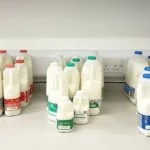Q: What is the Composition of Foods Integrated Dataset (CoFID)?
A: It is a dataset that contains nutrient data for 2,898 foods with a further 303 in the ‘old foods’ file, comprising of 185 individual nutrients. CoFIDS can be downloaded for free in MS Excel or Ascii format. Further information can be found in the User Document.
Q: Where can I find extra information relating to the sub-samples used in the Composition of Foods dataset?
A: Some of the nutrient values are 20-30 years old, and as such, the sampling documentation has been archived. For more recent surveys, links to the information can be found in report form on the ‘nutrients‘ page.
Q: Where are the samples prepared and analysed?
A: For the most recent analytical surveys, purchasing, sampling and storage of the samples has been organised and co-ordinated by the Quadram Institute (UK) whilst accredited laboratories, specifically Eurofins and LGC, carry out the analysis.
Q: I’ve found an error in the dataset or have a question. Who should I contact?
A: All questions and feedback including foods, which you feel are lacking or contain errors, should be sent to fnnbri@quadram.ac.uk.
Q: When will CoFID be updated?
A: The most recent update of CoFID was released in 2021. Further updates are planned annually, depending on funding and availability of new data.
Q: Which foods have been recently analysed?
A: Below is a list of the most recent analytical surveys:
- Nutrient analysis of key cuts of pork (2020)
- Nutrient analysis of fruit and vegetables (2017)
- Nutrient analysis of fish (2013)
- Nutrient analysis of processed foods with a particular reference to trans fatty acids, revised edition (2013)
- Nutrient analysis of eggs (2012)
- Nutrient analysis survey of biscuits, buns, cakes and pastries (2011)
Links to the reports can be found on the FNNBRI nutrients page in the Analytical surveys for CoFID updates section
Q: What are the rules for licencing the use of UK Food Composition Data?
A: The Composition of Foods integrated dataset files are available from the UK government web archive free of charge in Excel format, however the data itself is subject to use under the Open Government Licence for Public Sector Information. The information can be freely used but the source of the information must be acknowledged. Further information is available from http://www.nationalarchives.gov.uk/doc/open-government-licence/version/1/open-government-licence.htm.
Q: Where can I find further information on food labelling regulations?
A: In 2011 the European Parliament published a Regulation (EU) 1169/2011 on the provision of food information to consumers; this regulation includes new rules for nutrition labelling to be implemented by December 2016. FoodDrinkEurope have produced a detailed guidance document that will help food manufacturers with the issues involved in the new regulations.
Q: How do I access eBASIS?
A: eBASIS can be found at http://ebasis.eurofir.org/.
Access to eBASIS is by individual user name log in only. If you are interested in viewing the database please contact fnnbri@quadram.ac.uk.
Q: What is the origin of the plant list used?
A: The plants included in eBASIS are the 300 most commonly eaten food plants in Europe. A full list of plants with the edible plant part, scientific name and name in 15 languages is available as a hard copy or pdf, contact fnnbri@quadram.ac.uk for a copy.
Q: Who should I contact with eBASIS queries?
A: If you encounter any problems with the eBASIS database please contact pedro.cardenas-canto@quadram.ac.uk.
Q: Is there a user guide for eBASIS?
A: A user guide can be found in the ‘additional information’ page of eBASIS. There is also a YouTube video demonstrating how to use the database.
Q: I have some data I would like to add, can I do that?
A: Data include in eBASIS has been peer-reviewed and published. If you have found areas where information is lacking please let us know. If you would like to contribute for data entry, please contact us.
Q: How up to date is eBASIS? A: eBASIS is a growing online repository of critically-evaluated research information on food plant composition and biological effects comprising currently ca. 35,000 entries, from over 800 publications. The 300 plant foods included are both comprehensive and representative of those produced and/ or marketed in the different geographical areas of the UK/EU, described in 15 European languages.
Q: Who uses eBASIS?
A: Users come from regulators, academia and industry in Europe and globally. It is envisaged that primary users of eBASIS will be the regulatory affairs sector (e.g. assessment of genetically modified plants/novel food plants, supporting health claims/risk assessment), food industry (e.g. evaluation and development of novel foods) and researchers and epidemiologists.
Q: Can eBASIS be used to determine health claims?
A: eBASIS has a highly flexible reporting system that allows users to control what data are extracted and what information is displayed. The data are used to assess whether a component has been reported to have beneficial health effects and the nature of these benefits as well as quantifying levels at which any health benefits may be exerted.
Such information is essential to support or refute health claims as well as develop new functional foods. The large numbers of health claims received by EFSA, relating to plant-based bioactive compounds included in eBASIS, suggests it is a useful tool for evaluators to determine independently not only the completeness of health claim dossiers but also their validity. Conversely, eBASIS has potential for claimants compiling such dossiers.
Q: eBASIS Quality?
A: eBASIS data are fully documented and the origin of individual data points can be traced back to the original publications. All the processes that are associated with the extraction, evaluation and inputting of data are performed within a BASIS Quality System that ensures adherence to international quality standards (ISO and ILAC systems) and is guided by a fitness for purpose approach.
Q: Is the database being expanded?
A: eBASIS is being further extended in a four-year, 28-partner EU-FP7 project BACCHUS to include new information on bioactive compounds in berries and meats.
Q: What is the difference between eBASIS and ePlantLIBRA?
A: ePlantLIBRA has been produced as a development of eBASIS. eBASIS contains information on plant based foods and ePlantLIBRA contains all this information together with Plant Food Supplement (and their ingredients) bioactive compound composition, botanical information, beneficial bioactivity data, and, additionally new information on case-reports of adverse effects, as well as composition of potential contaminants fed in from the MoniQA contaminants database (www.moniqa.eu); and Fera’s HorizonScan database (www.horizon-scan.com).
Q: What is LanguaL™?
A: LanguaL™ is a Food Description Thesaurus. LanguaL™ stands for “Langua aLimentaria” or “language of food”. It is an automated method for describing, capturing and retrieving data about food. The Langual thesaurus provides a standardised language for describing foods, specifically for classifying food products for information retrieval. LanguaL™ is based on the concept that:
• Any food (or food product) can be systematically described by a combination of characteristics
• These characteristics can be categorised into viewpoints and coded for computer processing
• The resulting viewpoint/characteristic codes can be used to retrieve data about the food from external databases
Each food is described by a set of standard, controlled terms chosen from facets characteristic of the nutritional and/or hygienic quality of a food, as for example the biological origin, the methods of cooking and conservation, and technological treatments. LanguaL™ thus allows links to many different food data banks and contributes to coherent data exchange. LanguaL is the only generally recognised method in common use for describing, capturing and retrieving data about food, adapted to computerised national and international food composition and consumption databanks. http://www.langual.org/
Users Documentation
- For more information on the current CoFID dataset, please see the user guide at McCance and Widdowson’s The Composition of Foods Integrated Dataset 2021 (publishing.service.gov.uk)






